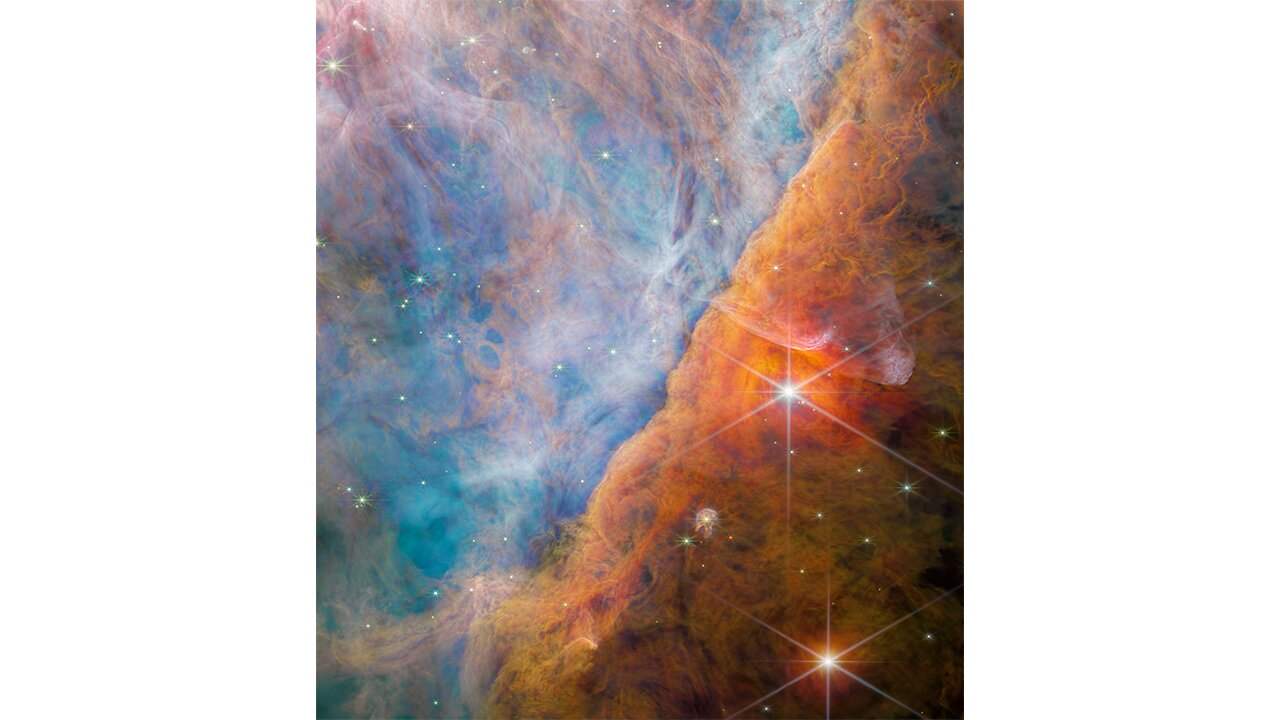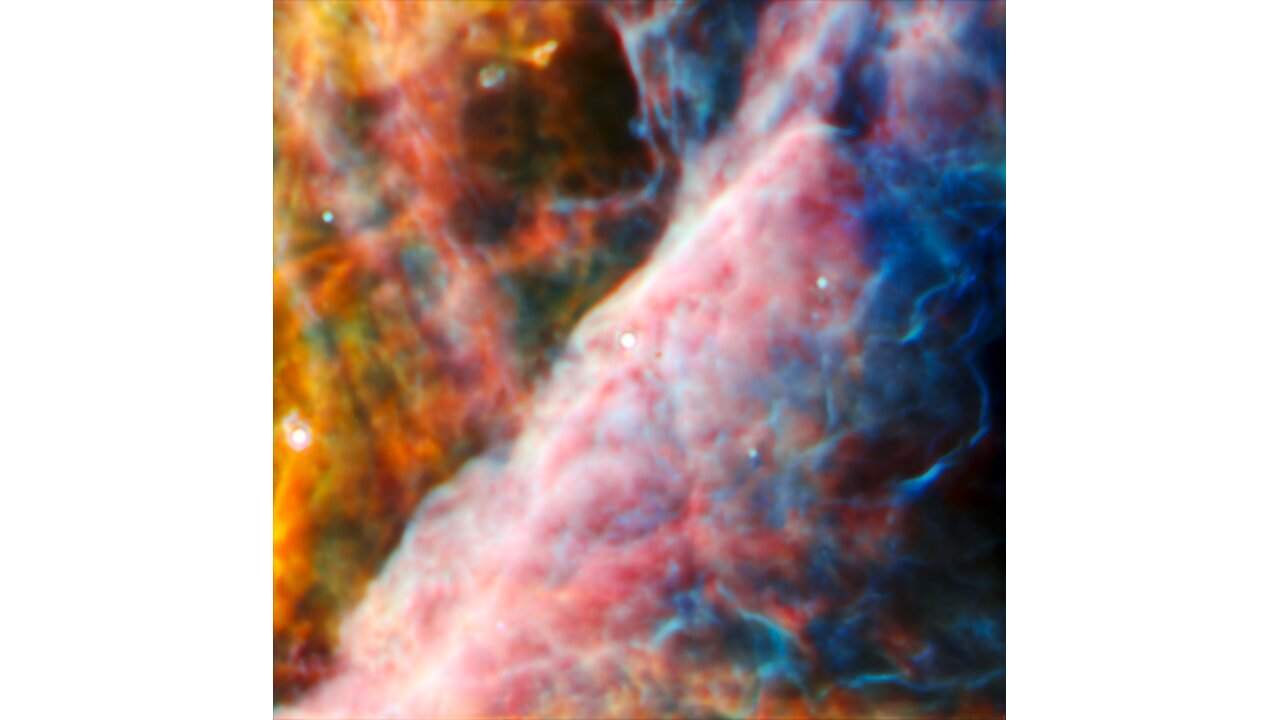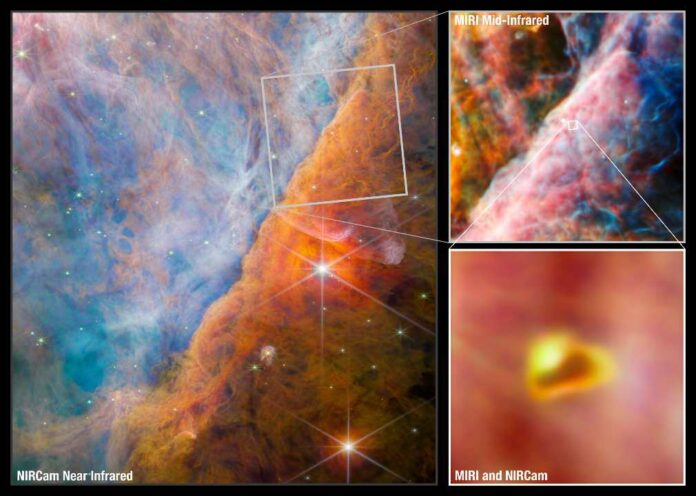A team of international scientists has used NASA’s James Webb Space Telescope to detect a new carbon compound in space for the first time. Known as methyl cation (pronounced cat-eye-on) (CH3+), the molecule is important because it aids the formation of more complex carbon-based molecules. Methyl cation was detected in a young star system, with a protoplanetary disk, known as d203-506, which is located about 1,350 light-years away in the Orion Nebula.
Carbon compounds form the foundations of all known life, and as such are particularly interesting to scientists working to understand both how life developed on Earth, and how it could potentially develop elsewhere in our universe. The study of interstellar organic (carbon-containing) chemistry, which Webb is opening in new ways, is an area of keen fascination to many astronomers.
The unique capabilities of Webb made it an ideal observatory to search for this crucial molecule. Webb’s exquisite spatial and spectral resolution, as well as its sensitivity, all contributed to the team’s success. In particular, Webb’s detection of a series of key emission lines from CH3+ cemented the discovery.
This video features NIRCam’s view of the Orion Bar region studied by the team of astronomers. Bathed in harsh ultraviolet light from the stars of the Trapezium Cluster, it is an area of intense activity, with star formation and active astrochemistry. This made it a perfect place to study the exact impact that ultraviolet radiation has on the molecular makeup of the discs of gas and dust that surround new stars. The radiation erodes the nebula’s gas and dust in a process known as photoevaporation; this creates the rich tapestry of cavities and filaments that fill the view. The radiation also ionises the molecules, causing them to emit light — not only does this create a beautiful vista, it also allows astronomers to study the molecules using the spectrum of their emitted light obtained with Webb’s MIRI and NIRSpec instruments. The two very large, bright stars are two of the three stars in the θ² Orionis system — the Trapezium Cluster is also known as θ¹ Orionis. The brightest star here, θ² Orionis A, is surrounded by particularly bright and red puffs of dust, which are reflecting the star’s light towards Earth. Its great brightness — it is visible with the naked eye — is due to the fact that θ² Orionis A is itself a ternary system made of three closely bound bright stars. Credit: ESA/Webb, NASA, CSA, M. Zamani (ESA/Webb), N. Bartmann (ESA/Webb), O. Berné and the PDRs4All ERS Team, Music: Stellardrone – Twilight
“This detection not only validates the incredible sensitivity of Webb but also confirms the postulated central importance of CH3+ in interstellar chemistry,” said Marie-Aline Martin-Drumel of the University of Paris-Saclay in France, a member of the science team. While the star in d203-506 is a small red dwarf, the system is bombarded by strong ultraviolet (UV) light from nearby hot, young, massive stars. Scientists believe that most planet-forming disks go through a period of such intense UV radiation, since stars tend to form in groups that often include massive, UV-producing stars.

This image taken by Webb’s NIRCam (Near-Infrared Camera) shows a part of the Orion Nebula known as the Orion Bar. It is a region where energetic ultraviolet light from the Trapezium Cluster—located off the upper-left corner—interacts with dense molecular clouds. The energy of the stellar radiation is slowly eroding the Orion Bar, and this has a profound effect on the molecules and chemistry in the protoplanetary disks that have formed around newborn stars here. Credit: ESA/Webb, NASA, CSA, M. Zamani (ESA/Webb), and the PDRs4All ERS Team
Typically, UV radiation is expected to destroy complex organic molecules, in which case the discovery of CH3+ might seem to be a surprise. However, the team predicts that UV radiation might actually provide the necessary source of energy for CH3+ to form in the first place. Once formed, it then promotes additional chemical reactions to build more complex carbon molecules.
Broadly, the team notes that the molecules they see in d203-506 are quite different from typical protoplanetary disks. In particular, they could not detect any signs of water.

This image from Webb’s MIRI (Mid-Infrared Instrument) shows a small region of the Orion Nebula. At the center of this view is a young star system with a protoplanetary disk named d203-506. An international team of astronomers detected a new carbon molecule known as methyl cation for the first time in d203-506. Credit: ESA/Webb, NASA, CSA, M. Zamani (ESA/Webb), and the PDRs4All ERS Team
These findings, which are from the PDRs4ALL Early Release Science program, have been published in the journal Nature.
“This clearly shows that ultraviolet radiation can completely change the chemistry of a protoplanetary disk. It might actually play a critical role in the early chemical stages of the origins of life,” elaborated Olivier Berné of the French National Center for Scientific Research in Toulouse, lead author of the study.
Reference:
Olivier Berné et al, Formation of the Methyl Cation by Photochemistry in a Protoplanetary Disk, Nature (2023). DOI: 10.1038/s41586-023-06307-x
